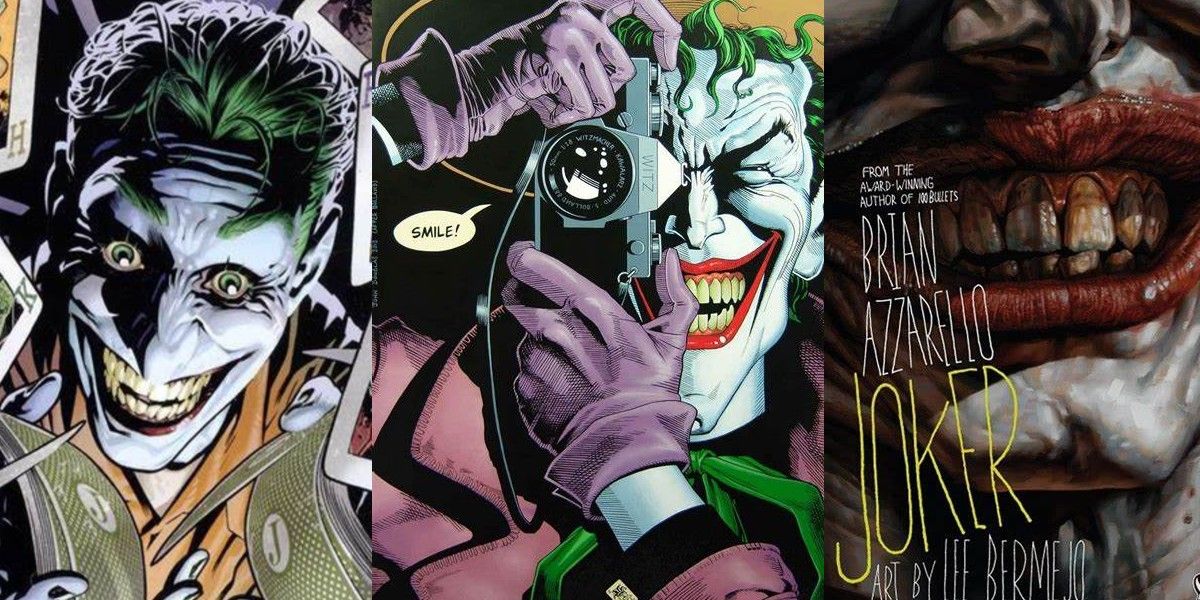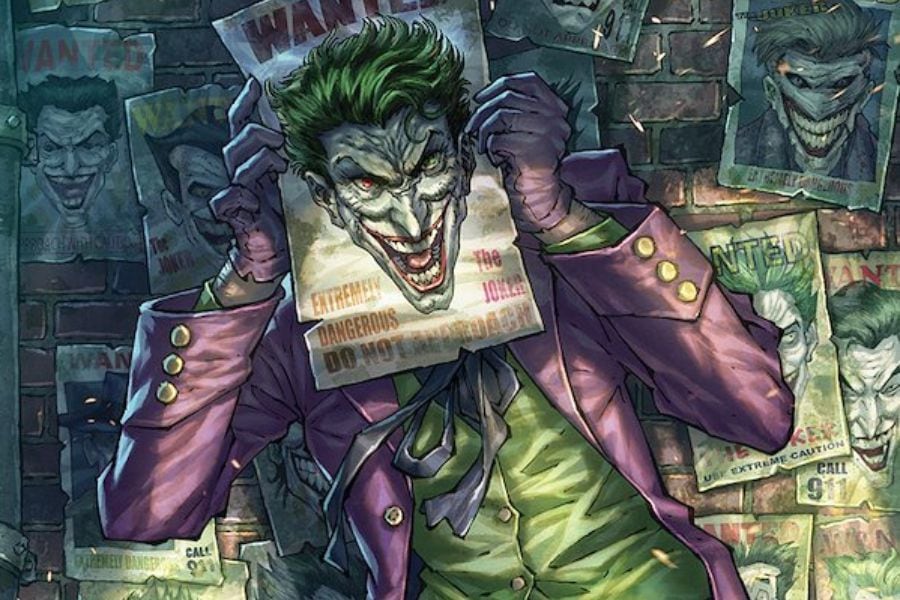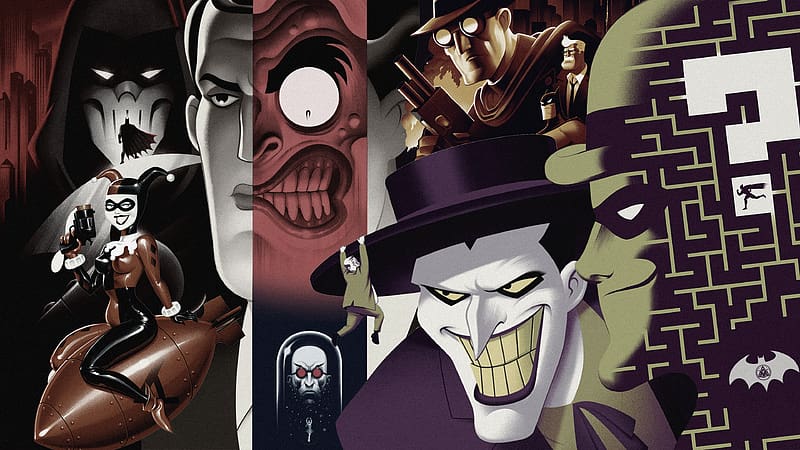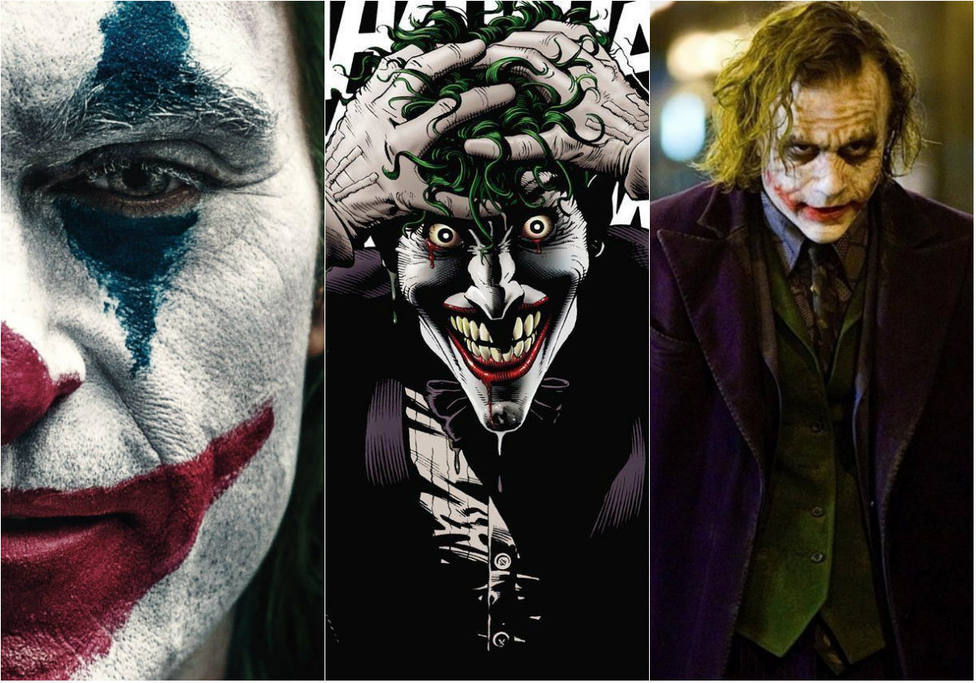Who Is The Joker?, Batman’s Nemesis And Most Notorious Villain
The Joker is one of the oldest and most famous villains of DC Comics. Since 1940, he has been Batman’s great enemy, considered his antithesis. Both characters complement each other thanks to their very opposite nature.
After some time away from the scene, the Joker returned in his last movie, a blockbuster, managing to rekindle the flame among fans. The feeling left of that thin line between good and evil and how society can lead a human being to cross the limits was brutal.
In this way, we can equate Joker’s fame to the Dark Knight’s. The former stands out for his outlandish costumes and grimace-like mouth, thus being a cultural icon. For this reason, we bring you the best review of the so-called clown of crime who lives in Gotham City and always appears to make Batman’s life miserable.
Who is The Joker?
 Image: DC Comics
Image: DC Comics
The Joker character is one of the longest-running villains in comic book history. He poses a threat to other villains and heroes of the DC Universe. Other persons rarely match his sinister and dangerous personality.
Little is known about his past, as the villain himself does not remember his origins. That is why seeing how the Joker’s story can change is so common. What is constant in the Joker is his apparent madness and his transformed appearance.
Since his early days, the villain has been a murderous psychopath who dresses as a clown. But, this was not always the case. DC had to change the essence of the character due to censorship imposed by the Comic Code Authority. Thus, they showed a harmless buffoon who liked to bother police officers.
Then came the era of the “Rebirth of Batman comics”. Together with the relaunch sponsored by Alan Moore, with The Killing Joke, the Joker recovers his sinister personality. Joker becomes so dark that he even murders defenseless children. This villain only wants to “see the world burn in anarchism and chaos”.
The Joker’s Creation and Development
The Joker first appeared in April 1940 in the first issue of the Comic Book Batman. Bill Finger created him conceptually, Bob Kane drew him, and the scriptwriter Jerry Robinson redesigned him.
The story was about a villain with a psychopathic personality, characterized by a twisted and sadistic humor. Although throughout his development, he has gone from a harmless buffoon to his darkest stage, as a child murderer.
This villain was born to be Batman’s counterpart, laughing and outrageous, who enjoys sowing chaos and terror in others. All this is contrary to what characterizes the Dark Knight, who is serious and always fights on the side of justice.
Actor Conrad Veidt, who played Gwynplaine in the 1928 film The Laughing Man, inspired the definitive drawing of the Joker. This villain is the cause of many of the misfortunes that follow Batman, such as the paralysis of Barbara Gordon, Batgirl, the death of Jason Todd, the second Robin, and Sarah Essen-Gordon.
Concept
 Image: DC Comics
Image: DC Comics
The initial concept since the creation of the Joker character is that of a villain with a disfigured face that gives him a permanent smile. His archetype has been associated with that of a talented trickster.
DC comics included several concepts to generate the Joker’s controversial personality, among which social engineering, theatricality, jokes and idiomatic humor stand out.
The character manages to indifferently capture the fans, perhaps, by alternating between witty humor and malicious violence. But, everything Joker does focuses on doing harm, lacking any ethics.
His raison d’être is to destabilize the status quo of society socially, economically and politically. At all costs, he seeks to reveal how hypocritical society is without hiding that what he does is for his own benefit.
Obtaining his powers
In itself, the Joker does not have superpowers like other villains. But, his body deformation hints at a contrast between the subhuman and the superhuman, trying to imply the absence of unity in body and mind.
In either version, either in Detective Comics #168 of 1951 or Alan Moore’s Batman: The Killing Joke, the character was an ordinary man. Trying to help his family, Joker ends up confronting Batman. And so, a chemical accident deforms his skin and face (strange and evil smile) and dyes his hair green.
The Joker’s History in comics
 Image: DC Comics
Image: DC Comics
The history of comics has had an essential evolution in different stages, such as:
Golden Age
In the Golden Age, DC presents the Joker in its original version, a psychopathic serial killer. He is seen for the first time in 1940, Batman #1, with a grotesque physical appearance. A Joker with a sinister smile inspired this character.
Joker would take his victims and murder them with what he called “The Joker’s Venom”. The poison was a toxin of his own making that disfigured the faces of his victims, leaving him with a grotesque grin.
Silver Age
At first, the onslaughts and changes of the Silver Age did not affect Batman’s print runs. Then DC showed the origin of the Joker as Red Hood, a criminal with a cape and red hood who tries to make a raid on a chemical plant. In the escape, he falls into a toxic waste pit, disfiguring his face.
But, as this stage began to progress, public disapproval of the violence generated by the comics grew. That completely changed the Joker’s origin, turning his personality into a prankster and nonsense.
Bronze Age
The previous stage caused the Joker to stop appearing with the same frequency in the comics. So, after four years of absence, he reappeared in 1973 in The Joker’s Five-Way Revenge, from Batman # 251.
In this age, the impulsive, maniacal and homicidal personality with which the villain appeared for the first time resumed. For this, Neal Adams illustrated the character with screenwriter Dennis O’Neil.
By the 1970s, DC Comics stepped up its advertising campaign, placing the Joker as its primary antagonist. DC wanted to show that the villain could confront Batman and any other villain or superhero present.
Modern Age
In this contemporary stage, the Joker’s darker personality develops. He went from being a narcissistic clown to a maniac, psychopath, and ruthless murderer. Joker created a particular ingenuity to commit his atrocious acts at this stage.
By the 1980s, this villain exerted a remarkable impact on Batman stories. So, while other superheroes were dying in the industry, DC maintained the Dark Knight thanks to his counterpart. Likewise, at this stage, DC again highlights an evident protest of the Joker towards society.
The Joker Character Biography
 Image: DC Comics
Image: DC Comics
The Joker’s character biography varies depending on the era:
Origins
The origin of the Joker’s character is not very clear. Each comic book of his era tells a somewhat different version. But, perhaps this is because this character is a liar by nature.
On several occasions, this villain has confessed that he does not remember how he became this bizarre psychopath. His confusion still needs to be clarified, but if one thing is sure, he enjoys sowing this uncertainty.
For this reason, it is customary to see in several comics how the origin of the Joker varies, as in:
- 1951, Detective Comics # 168. Joker disguises himself as a criminal to rob a chemical plant, and Batman thwarts his attempt.
- The Killing Joke, he is a chemical plant attendant who becomes a comedian.
- Issues of Batman: Gotham Knights #50-55 show him kidnapping and murdering the Joker’s wife, forcing him to participate in a corporate chemical heist.
- Batman #450 and Batman Confidential #7-12 show similar origins of the Joker, where he assumes the persona of a villain, confronting Batman, and Batman wounds him in the face.
Alternate Versions
The Joker has several alternate versions according to DC’s alternate universes, as in:
- Batman and Joker -in The Dark Knight Returns– both have aged, and it ends with the villain’s death.
- In other publications, the Joker is a computer virus or hero tasked with defeating the tyrant Batman.
- Other versions are entirely different from the original essence of the character, as in Flashpoint124, where Martha Wayne takes on the Joker.
- We see another version in Emperor Joker, which features a crossover with the Superman universe.
- Or in 2005, in Infinite Crisis, the Joker kills Alexander Luthor to exclude him from the Secret Society of Villains.
Distinctive Elements of the Character
 Image: DC Comics
Image: DC Comics
The Joker has distinctive elements that have made him stand out throughout his career in the world of comics, such as:
Characterization
The Joker’s characteristics are emblematic, such as:
- Dangerous criminal and psychopath.
- Insane, cruel, ruthless, sinister and manipulative.
- Dark humor, twisted and eccentric.
Personality
Historically it is usual to see the Joker as a split personality. In one, he is Batman’s bitter villain, a psychopath, sadist and murderer with twisted humor. And in the other, he is a harmless thief, joker, eccentric, and above all, harmless. But in both cases, he enjoys torturing his victims.
The obsession with Batman is a prominent characteristic of this villain. Many authors compare with the Yin and Yang, so one does not exist without the other. Unlike Batman, a hero in the shadows, the Joker has characteristic features of humour.
Another of the Joker’s qualities is that his crimes are staged, i.e. he needs theatricality. That goes far beyond whether his actions are productive or not. On many occasions, he is indifferent, but the truth is that he does everything seeking the desperate approval of the superhero.
He almost always gets away with it, where, despite being learned, he evades justice by pleading insanity. And, when he is transferred to mental hospitals for care, he escapes.
In fact, many of his actions a the Dark Knight to commit murder. Therefore, the Joker does not hesitate to risk his life, showing that he does not possess the instinct of self-preservation. Thus, this villain has an irrational personality representing everything Batman hates.
The Joker’s Ability and Equipment
The Joker lacks superhuman abilities to do his misdeeds. So, he usually resorts to his wit and lethal equipment to make his actions effective. Such as:
- Varied and lethal weaponry, such as detonators, C-4, hand weapons, shotguns, pistols, and rocket launchers. It also uses toxins such as Joker Spores. He uses bladed weapons such as blades and knives.
- Expertise in close combat, demonstrating excellent resistance to blows, resulting in a great opponent.
- Superior intelligence and ingenuity in planning crimes, managing to outwit the authorities several times.
- Expert in chemistry and engineering, managing to generate explosives and powerful detonators. In addition, he is famous for using steel cards, surprise boxes, cigarette-shaped explosives, and nitrogen oxide bombs to kill people with laughter.
- Photographic memory allows Joker to identify victims by simply hearing their voices or remembering their faces.
The Joker’s Relationships

If there is one thing that distinguishes the Joker, it is his homicidal and unpredictable nature. It is not for nothing that he is considered one of the most feared villains in DC Comics by villains and superheroes alike.
Among his most frequent collaborators are:
- Penguin,
- Two-Face,
- Lex Luthor,
- Gaggy Gagsworth,
- Riddler,
- Killer Croc and
- Scarecrow
But, this villain usually frequently disagrees with any of his companions because of his ideas and decisions. Many agree to help him for intimidation or money. However, the fear he generates makes his henchmen vulnerable to his requests.
The Joker in Other Media
 Image: DC Comics / Warner Bros. Pictures
Image: DC Comics / Warner Bros. Pictures
It would be logical that a character of this magnitude is present in other media, on small and big screens, and in video games. Jack Nicholson was one of the actors who played the darker version of the Joker. Also, actor Joaquin Phoenix has played this character. Actually, we will see him playing the fascinating villain again in Folie à deux, the Joker sequel, to be relased on October 2024.
Literary analysis
The character of the Joker is the subject of different psychological and political currents. In such a way, some hypotheses see the character with Marxist inclinations and Batman as a Capitalist.
The Joker is projected as everything that opposes the image of capitalism, rejecting authority to obtain freedom without restriction. However, the villain maintains his power to consolidate and coerce others.
The Joker is often an average lower-class person. He loses his sanity due to the failures and abuses of the social system itself. That represents a straightforward protest against our current society and its prevailing system.
Cultural Impact and Legacy
One of the most recognized characters in popular culture is the Joker. He is, of all time, one of the best villains that has passed through DC Comics. From the first time he stepped on the scene until now, he has allowed Batman to stay in the limelight.
The Joker is “one of the four most recognizable comic book characters.” His impact has the level of other superheroes, such as Batman, Spider-Man or Superman.
Due to his popularity, DC included him in Greatest Stories Ever Told (1987-1988). Ethically, it has generated such controversy that it has made right from wrong, so much so that Batman has thought of murdering the Joker to save his victims with a greater purpose.
Featured Image Via DC Comics









Leave a comment